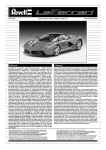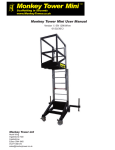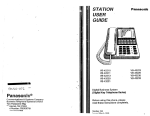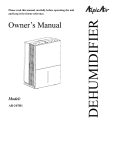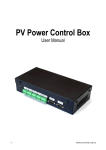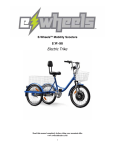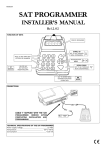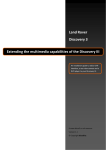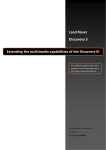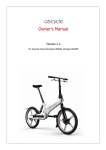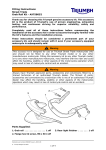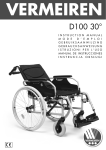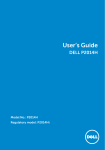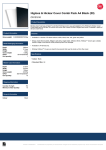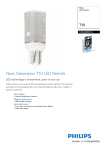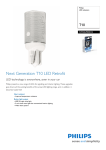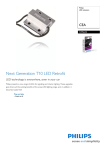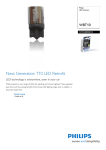Download Monkey Tower User Manual
Transcript
Monkey Tower Scaffolding in 5 Minutes www.MonkeyTower.co.uk Monkey Tower User Manual Version 11.2 EN 1298 IM en 13/07/2010 Monkey Tower Ltd North Wing Ingatestone Hall Ingatestone Essex CM4 9NS 01277 356172 [email protected] Contents Contents 1 Safety Rules 3 2 Operating Instructions 4 3 Pre-Use Inspection 9 4 Hazardous Situations 13 5 Fault Finding 16 6 Specifications 17 User Manual 2 Monkey Tower Ltd Chapter 1. Safety Rules work methods (practices) and adequate facilities/ resources (including work equipment) are provided to eliminate or minimise risks, Work at Height Regulations 2005, Regulations 6, 7, 8 and Schedule 3 Part 2. Chapter 1 Do Not Operate Unless: • You learn and practice the principles of safe machine operation contained in this operator’s manual. You must: Safety Rules 1. Know, understand and follow the safety rules in this Chapter. Failure to obey the instructions and safety rules in this manual may result in death or serious injury. 2. Follow the operating instructions, Chapter 2. 3. Avoid hazardous situations, Chapter 4. Important Information 4. Always perform a pre-operation inspection at the required interval, Chapter 3. • This manual should remain with the machine at all times. 5. Always perform function tests prior to use, Chapter 3. • If you have any questions contact Monkey Tower Ltd. 6. Inspect the workplace, Chapter 3. • You read, understand and obey the manufacturer’s instructions and safety rules including the safety and operator’s manuals and machine decals. Introduction This instruction manual contains all the information required to correctly assemble the Monkey Tower to provide collective measures enabling full compliance with the Work at Height Regulations 2005. • You use the machine as it was intended. This Manual should be used in conjunction with a suitable Risk Assessment and Method Statement relative to the project to be undertaken, Work at Height Regulations 2005, Regulation 6(1). It must be noted that all employers have a responsibility to ensure that • You read, understand and obey all applicable governmental regulations. User Manual • You read, understand and obey employer’s safety rules and worksite regulations. • You are properly trained and experienced to safely and competently operate the machine. 3 Monkey Tower Ltd Chapter 2. Operating Instructions • Follow the Setup procedures in the Function Tests section. Raising Platform for Use Chapter 2 1. Position the machine directly below the desired work area. 2. Extend each leg horizontally and lock into position with the leg pins. The second hole should be used unless a) the platform is below 3m when the holes nearest the leg can be used, or (b) the tower is braced against or tied into a solid wall when the holes nearest the leg can be used on the wall side. Operating Instructions Fundamentals The Operating Instructions section provides instructions for each aspect of machine operation. It is the operator’s responsibility to follow all the safety rules and instructions in the operator’s manual. If more than one operator is expected to use a machine at different times in the same work shift, each operator is expected to follow all safety rules and instructions in the operator’s manual. That means every new operator should perform a pre-operation inspection, function tests and a workplace inspection before using the machine. 3. Loosen star-knobs on levelling jacks. 4. Lower the levelling jacks equally by turning handle anticlockwise and lock the castors by pushing castor-lock down with foot. Setup • Check that work area is suitable according to the details given in the Site Inspection / Machinery Selection section of Chapter 3. User Manual 4 Monkey Tower Ltd Chapter 2. Operating Instructions 5. Adjust the levelling jacks to level the machine. Both of the bubble levels must have the bubble completely within the large circle road-wheels must be clear of the ground. 6. Check that all four legs are in firm contact with the ground and tighten starknobs on leg jacks. 7. Lift ladder to the vertical position. 10. Raise platform by approximately 30cm (1 foot) by turning winch in the up direction (Ratcheting sound will be heard from winch). Not to be used to raise people 8. Check ladder locks have locked into position. 11. Flip all brace-locks over such that they are in the ready, locked position. 9. Check rung-lock cables on ladders are all loose by pulling the bottom end of the cables straight down and releasing. User Manual 12. Continue winding winch to raise platform until the platform is above the desired height. 5 Monkey Tower Ltd Chapter 2. Operating Instructions • Continue climbing through trapdoor aperture and step backwards onto platform. 13. Lower platform (by winding winch in opposite direction to raising) until neither side of the platform lowers any further. 14. Wind winch in by approximately 1/4 turn to set winch on ratchet and take in cable slack. 15. Check that all brace-locks and rung-locks are fully engaged. If locks are not engaged repeat steps 9 to 14. 16. If platform is 3m (or higher) lock guy ropes in by placing stabilizer hook through guy rope loop and pulling handle down. Note that guy ropes are not effective when the stabilizers are in the inner horizontal position. Do not extend the height of the platform by climbing on the guardrails or using ladders, boxes etc. Climbing Ladder & EnterExiting and Lowering Platform ing Platform Do Not raise or lower platform Before the ladder is climbed the following or undo any locks when personnel are on Monkey Tower checks must be made each time: 1. Open trapdoor and exit platform via ladder. • Check that the tower is still correctly levelled by use of the bubble levels. 2. Release guy-ropes by lifting hook handle. • Check that the assembly is still correct and complete. 3. Pull any rung-lock cables within reach downwards to apply tension to cable and sideways to lock the cable in place. • Check that both sets of brace locks and ladder locks are locked into place. 4. Wind winch to raise platform approximately 20 cm (9”) to disengage runglocks and brace-locks. • Climb ladder inside platform using rungs for handholds and maintaining 3 points of contact at all times. 5. Flip any brace-locks within reach over. • Raise trapdoor until magnetic catch holds trapdoor in place. User Manual 6. Lower platform. 6 Monkey Tower Ltd Chapter 2. Operating Instructions 7. If platform stops lowering repeat steps 3 Never move the Monkey Tower with to 6. workers on board. When platform raised do not move 8. Disengage ladder-locks and lower ladunless ground is smooth, level and free from der to transport position. drop-offs, ledges or debris. 9. Loosen star knobs and raise levelling If windspeed is over 17mph (beaujacks by turning handle. fort force 4) or ground conditions are poor fully lower the tower before moving. 10. Remove leg pins. Avoid sudden starts and stops. Keep person11. Retract each leg horizontally and lock nel away from the machine when moving. into position with the leg pins. Lifting tools Moving on Castors 75kg of tools or equipment can be lifted on the platform of the Monkey Tower. Simply The Monkey Tower can be moved through place the tools or equipment on the platform small distances on the the castors and jockey prior to raising the tower. Be aware of safe wheel. The tower shall not be moved with a manual handling when lifting tools or equipplatform height of over 3m. ment onto the platform. 1. If platform over 3m high, lower platform to 3m height. Towing 2. Unlock castor by lifting castor-lock by hand. • Check all jacks are fully raised and in the inner position with detent pins fully inserted and star-kobs are tightened. 3. Release jockey wheel clamp. Lower jockey wheel and lock into position. Raise tower by turning jockey wheel handle. 4. • Check ladder has been lowered into the storage position. • Attach break-away cable to substantial integral point on tow vehicle. Front legs nearest the jockey must be down with the legs no more than 3cm from the ground • Attach tow-hitch to suitable toe-ball on tow vehicle. 5. Move Monkey Tower. • Attach lighting connector to tow vehicle and check lighting works. 6. Lower tower by turning jockey wheel handle. • Check axles are extended to the outer towing position and that lock pins are fully inserted. 7. Lock castors. User Manual 7 Monkey Tower Ltd Chapter 2. Operating Instructions • Check Starknobs on axles are fully The tower shall never be used when tightened. lifted or suspended. • Check numberplate on Monkey Tower matches numberplate on towing vehicle. • Check towing capacity of tow vehicle (Monkey Tower weight given in Specification Section). • Check the trailer visually for damage. • Check tyre pressures, condition and tread depth. WARNING If the • Check wheel condition. wheel is damaged, it is possible that the stub axle or complete axle may have been damaged, refer to Maintenance Manual. • Gripping the towing eye or ball in both hands, pull back and forth, up and down, feel for excessive moment. • Check the attachment of the Coupling Body to the Drawbar for any cracks or signs of stress. The Monkey tower should always be towed in the storage position. Never tow with any personnel or equipment aboard the Monkey Tower. Lifting Monkey Tower The weight and size of a Monkey Tower make it unsuitable for manual lifting. Lifting lugs uitable for craning the Monkey Tower are built into the ends of the leg tubes. All parts should be secured prior to lifting and competent lifting operators used. User Manual 8 Monkey Tower Ltd Chapter 3. Pre-Use Inspection quired. If damage or any unauthorized variation from factory delivered condition is discovered, the machine must be tagged and removed from service. Repairs to the machine may only be made by a qualified service technician, according to the manufacturer’s specifications. Chapter 3 Pre-Use Inspection Frequency of inspection The pre-use inspection should be made at the following frequency: The pre-use inspection is a check on the correct functioning of the Monkey Tower, operator competency and site conditions. The pre-use inspection is carried out in conjunction with the Inspection Record MTIN-001 (a copy of which can be found on the back cover of this manual). • After installation in any position (note:this does not mean every time that the Monkey Tower is moved on site) • After exceptional circumstances which are liable to jeopardise the safety of the Monkey Tower or other work equipment. Inspection Record MTIN-001 1. Name and address of company for whom inspection carried out. Function Test Serial Number Operators Manual Present Decals Present Damage, Dirt, Missing Parts, Corrosion, Unauthorised Changes Stabiliser Leg Function Bubble Function Magnet Operation 2. Site address 3. Location of the place of work. 3. Time & date of inspection 5. Name & position of inspector. 6. 7. 8. 9. 10. 11. 12. Thorough inspection up to date (sticker on inside of ladder) – Yes / No Daily / pre-operation inspection completed & recorded – Yes / No Site inspection / machinery selection complete – Yes / No Wind speed measured – Yes / No ................. Rescue procedure complete – Yes / No Operator familiarized & competent to use Monkey Tower – Yes / No Details of any matter identified that could give rise to a risk to the health or safety of any person. • At suitable interval not exceeding every 7 days. Ladder lifting / locking Cable Condition & Direction Synchronisation on Raising Runglock Function Guy Rope tension Thorough inspection up to date 13. Can work be carried out safely – Yes / No 14. If work cannot be carried out safely name and position of person informed 15. Details of any other action taken as a result of matters identified in 12 above. The thorough inspection is a requirement under the LOLER (Lifting Operations and Lifting Equipment Regulations 1998). For the Monkey Tower a Loler inspection is required at a maximum yearly interval. A reminder sticker detailing when the next inspection is The pre-use inspection also serves to deter- due is usually placed on the inside of the ladmine if any maintenance procedures are re- der. 16. Details of any further action considered necessary. 17. Date and time report handed over 18. Name and position of person receiving the report The inspection regime given here is not exclusively for Monkey Tower but based on the HSE guidelines for work platforms (Scaffold Towers or MEWPS) http://www.hse.gov.uk/pubns/cis47.pdf and the working at height regulations 2005 User Manual 9 Monkey Tower Ltd Chapter 3. Pre-Use Inspection Function Test • Legs. • Stabilizers. It is the responsibility of the operator to perform a function test. The function test is a visual inspection performed by the operator prior to each work shift. By following the order laid out here the funtion test can be performed whilst erecting a tower. • levelling jacks. • Sliders. • Cable (check for kinks, frays, abrasions). • Pulleys. Operators Manual Present • Cable attachments. Be sure that the operator’s manual is complete, legible and readily accessible by users. • Wheels. • Castors. • Nuts, bolts and other fasteners. Decals Present Be sure that all decals are legible and in place. Check the entire machine for: • Dents or damage. • Corrosion or oxidation. • Cracks in welds or structural components. Be sure that all structural and other critical components are present and all associated fasteners and pins are in place and properly tightened. Damage, Dirt, Missing Parts, Stabiliser Leg Function Corrosion, Unauthorised Changes Check the following function on all four of the Check the following components or areas for stabiliser legs: damage, excessive dirt or contamination, improperly installed or missing parts and unau• Detent pins slide in and out of holes easthorized modifications: ily with spring-loaded ball locking the pins into place. • Winch and related components. • stabilisers slide horizontally without • Base components. undue force. User Manual 10 Monkey Tower Ltd Chapter 3. Pre-Use Inspection • Star knobs are in position and in good Cable Condition & Direction condition. Be sure that • Legs wind up and down easily without • There is a minimum of 4 wraps of caundue force. ble around the winch drum when the platform is fully lowered. • Castors are in position on the rear two legs and function correctly. • The cable is wrapped around the winch in the correct direction (i.e. when the winch is wound in the direction shown Bubble Function by the up arrow the platform raises and a clicking sound is heard from the Check that: ratchet mechanism) • Pulley beneath winch is in good condition. • Two bubble levels are present, (one at the front and the other at the back of the machine): • Bubble levels are firmly attached to the platform. • Visible portion of cable is in good condition. (no flat spots, kinks or frays) Synchronisation on Raising • Bubble levels have bubble present and Check for the correct synchronisation on raisare capable of both being levelled. ing the tower of the following components: Magnet Function Ladders. Short ladder section should raise before the longer middle ladder section. Check that the magnets holding open the Diagonal Brace. The middle tube should only trapdoor and the trapdoor toeboard (if fit- raise once the largest outside tube is fully raised. ted) are hoold the relevant part firmly. Ladder Lifting / Locking Check that: Main sliders. The sliders should raise in order with the sliders nearest the platform raising before the other sliders. Lock Function • Ladder raises into use position easily Check that the locks on the ladders and diagfrom towing position. onal brace move in and out of position easily and that the bungey cables are in good con• Ladder locks hold ladder in position. dition. User Manual 11 Monkey Tower Ltd Chapter 3. Pre-Use Inspection Wind Speed Measurement Guy Rope Tension Check that with the legs held in the 2nd hole The maximum windspeed that a freestandout the guy ropes attach tightly and that the ing Monkey Tower shall be used in is 17mph guy rope latches latch firmly. (beaufort force 4). The windspeed should be checked at the beginning of work and rechecked if any changes in the windspeed are Site Inspection / Machin- noticed. The windspeed can be measured by use of an anemometer measuring the windery Selection speed in two perpendicular direction. Alternatively the beaufort scale can be used (BeauThe site inspection determines if the work- fort force 4 is described by dust and loose place is suitable for safe machine operation. paper being raised and small branches beginWorkplace inspection should be performed by ning to move. For Beaufort force 5 branches a competent person prior to moving the ma- of a moderate size move and small trees in chine to the workplace. leaf begin to sway.) Be aware of and avoid the following haz- Be aware that local windspeed conditions can ardous situations: be higher than surrounding areas especially in cases such as working between buildings, on the corners of buildings, open ended buildings • Low ground bearing capacity. etc. • Drop-offs or holes. • Bumps and floor obstructions. Rescue Procedure • Debris. In the incidence of a user being incapaci• Sloping surfaces (maximum slope 1 in tated and requiring medical attention whilst 7). in the raised platform of the Monkey Tower the emergency lowering procedure is to lower • Unstable or slippery surfaces. the Monkey Tower with the person on the platform. It is therefore recommended that • Overhead obstructions. there is at least one other person on site that • High voltage conductors. is capable of lowering the Monkey Tower. • Inadequate surface support to withstand all load forces imposed by the machine. Check that the Monkey Tower is suitable for the intended job i.e. is there sufficient height to reach the workplace, can the workplace be reached from within the platform. User Manual 12 Monkey Tower Ltd Chapter 4. Hazardous Situations • Ensure platform trapdoor is closed when working. Tip-over Hazards Chapter 4 Hazardous Situations • Do not raise the platform unless the legs have been fully extended, lowered and locked, the casters are in full contact with the ground and the base is level. Fall Hazards • If the Monkey Tower is to be used against a sturdy wall the legs adjacent to the wall can be used in the inner position, however the ends of the legs must be in contact with the wall. • Do not use the machine as a personnel lifting platform. Monkey Tower is not to be used to lift or lower people. • Do not climb tower unless ladders and diagonal brace are locked into position and winch cable is tight. • If occupants of the platform are required to wear personal fall protection equipment (PFPE) due to job site or employer rules, PFPE equipment and its use shall be in accordance with the PFPE manufacturer’s instructions and applicable governmental requirements. • Do not sit, stand or climb on the platform guard rails. • Maintain a firm footing on the platform floor at all times. • Keep the platform floor clear of debris. User Manual 13 • Do not impose a side load of more than 200N. Be aware of possible sideloads arising from work (pressure blasting, drilling etc.) • Do not raise the platform unless the leg retainer pins are properly inserted through the leg and the base. • Do not remove the leg detent pins while the machine is loaded and/or raised. • Do not raise the platform unless the machine is on a firm surface and levelled. • Do not level the machine with blocks or other means except the leg jacks. • Do not move the machine with a raised platform. • Do not operate the machine in strong or gusty winds (max windspeed 17mph, beaufort 4). Monkey Tower Ltd Chapter 4. Hazardous Situations • Do not increase the surface area of the platform or the load. Electrocution Hazards • Do not place ladders or scaffolding against any part of the machine. This machine is not electrically insulated and • Do not use the machine on a moving or will not provide protection from contact with, mobile surface or vehicle. or proximity to, electrical current. • Do not exceed the rated load capacity. (See Specifications Section). • Keep away from the machine if it contacts energized power lines. Personnel must not touch or operate the machine until power lines are shut off. • Do not adjust or remove the outriggers while the platform is occupied or raised. • Do not place or attach overhanging loads to any part of this machine. • Keep away from electrical power lines and apparatus. Allow for machine movement and electrical line sway or sag, and be aware of strong or gusty winds. • Do not raise tools and materials unless they are evenly distributed and can be safely handled by person(s) in the platform. • Do not exceed the rated lifting load (see Load Capacity Section) • Do not use the machine as a ground for welding. • Do not push off or pull toward any object outside the platform. • Do not operate the machine during lightning or storms. • Do not operate the machine near dropoffs, holes, bumps, debris, unstable or slippery surfaces or other possible hazardous conditions. • When moving the machine with a forklift or other transport vehicle (i.e. towing), the platform should be fully lowered, the ladders should be down and no personnel, tools or materials shall remain in the platform. Crushing Hazards • Do not modify or alter the Monkey Tower without prior written permission from the manufacturer. • Do not exceed the Safe Working Load see specifications chapter. User Manual 14 • Do not raise or lower the platform unless the area below is clear of people and obstructions. • Keep hands and fingers away from potential pinch points. Monkey Tower Ltd Chapter 4. Hazardous Situations Collision Hazards • Check the work area for overhead obstructions or other possible hazards. • Do not lower the platform unless the area below is clear of personnel and obstructions. • Be careful when transporting on an incline. • Be careful when towing, especially when reversing. • Be careful when moving by hand and avoid obstacles. Damaged Machine Hazards • Do not use a damaged or malfunctioning machine. • Conduct a thorough pre-operation inspection of the machine and test all functions before each work shift. • Immediately tag and remove from service a damaged or malfunctioning machine. Any damaged parts or incorrect components shall not be used. Routine Maintenance Details of routine maintenance can be seen in the Monkey Tower Maintenance Manual. User Manual 15 Monkey Tower Ltd Chapter 5. Fault Finding • Check guy rope cables have been released. • Check that there are no obstructions to the ladder, slider or brace-lock. Chapter 5 Ladder Fails to Lower • Check that platform has been fully lowered. Fault Finding • Check that there are no obstructions to the ladder, slider or brace-lock. Fault Finding Diagnostics Platform Fails to Raise If none of the solutions below fix the problem please refer to your Monkey Tower distributor or Monkey Tower Ltd. • Check that the winch is functioning and that the cable is firmly attached. • Check that there are no obstructions on the sliders or ladders. • Check that ladder has been raised to a vertical position. • Check that winch cable is intact. • Check that platform is not overloaded. Platform Fails to Lower • Check that all rung-locks and bracelocks have been released. (Platform may need raising to release rung-locks). • Check that rung-lock cables are intact. User Manual 16 Monkey Tower Ltd Chapter 6. Specifications Width* - 1m (3’2”). *for max working height 5m. Towing Dimensions Chapter 6 In the towing position the Monkey Tower has dimensions of: Height - 2.1m (6’10”). Length - 3.3m (11’). Width - 1.1m (3’8”). Specifications Class - Class III Tower Weight - 380 kg. Safe Working Load - 250 kg. Lifting Capacity - 75 kg. Max Platform Height - 4.5m (14’9”). Maximum Working Height - 6.5m (21’). Height Increment - 0.25m (10”). Wind limits Windspeed (mph) 0-17 0-21 Windspeed (Beaufort) 0-4 5 21 + 6+ Minimum Dimensions With the stabilisers and towbar removed and the telescopic wheels slid in the Monkey Tower has minimum dimensions of: Height* - 1.9m (6’3”). Length - 2.6m (8’8”). Width - 0.7m (2’4”). *Height when tipped - for instance, to pass through door. Action Use as normal Tie platform to solid structure or lower tower Do not use and lower tower Load Capacity No loads are to be carried in the Monkey Tower whilst it is being towed. Tyres 8” tyres should be used. In the EU tyres should be marked with a Load Index (LI) and Speed Rating. Tyres with a Load Index (LI) The minimum area required for a Monkey of 67 (307kg) or greater should be used and Tower is: the speed rating adhered to. Tyre pressures Height - 2.1m (6’10”). should be as given on the tyres. Length - 2.6m (8’8”). Width - 1.3m (4’4”). Footprint User Manual 17 Monkey Tower Ltd Inspection Record MTIN-001 1. Name and address of company for whom inspection carried out. 2. Site address 3. Location of the place of work. Function Test Serial Number Operators Manual Present Decals Present Damage, Dirt, Missing Parts, Corrosion, Unauthorised Changes Stabiliser Leg Function Bubble Function Magnet Operation Ladder lifting / locking Cable Condition & Direction Synchronisation on Raising Runglock Function Guy Rope tension 3. Time & date of inspection 5. Name & position of inspector. 6. 7. 8. 9. 10. 11. 12. Thorough inspection up to date (sticker on inside of ladder) – Yes / No Daily / pre-operation inspection completed & recorded – Yes / No Site inspection / machinery selection complete – Yes / No Wind speed measured – Yes / No ................. Rescue procedure complete – Yes / No Operator familiarized & competent to use Monkey Tower – Yes / No Details of any matter identified that could give rise to a risk to the health or safety of any person. 13. Can work be carried out safely – Yes / No 14. If work cannot be carried out safely name and position of person informed 15. Details of any other action taken as a result of matters identified in 12 above. 16. Details of any further action considered necessary. 17. Date and time report handed over 18. Name and position of person receiving the report The inspection regime given here is not exclusively for Monkey Tower but based on the HSE guidelines for work platforms (Scaffold Towers or MEWPS) http://www.hse.gov.uk/pubns/cis47.pdf and the working at height regulations 2005


















